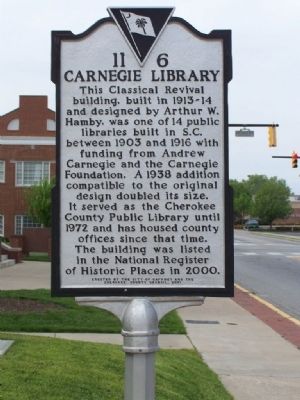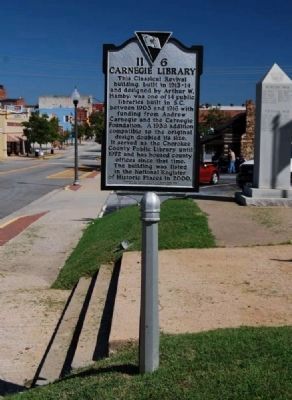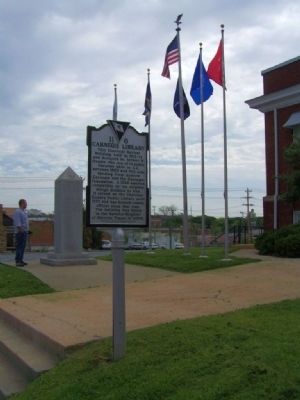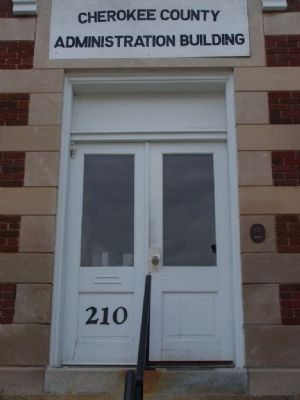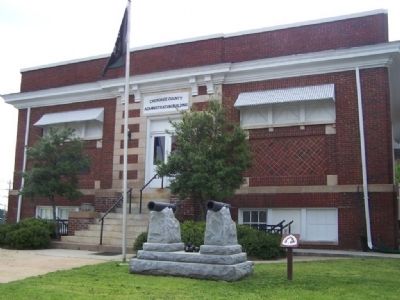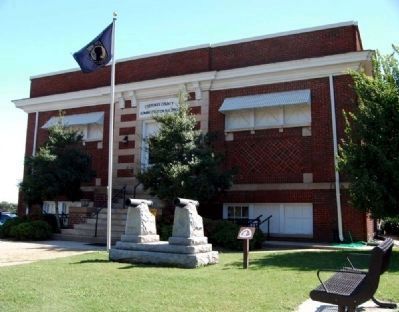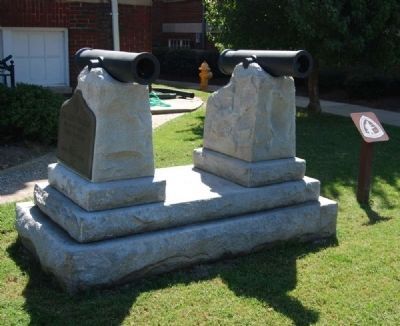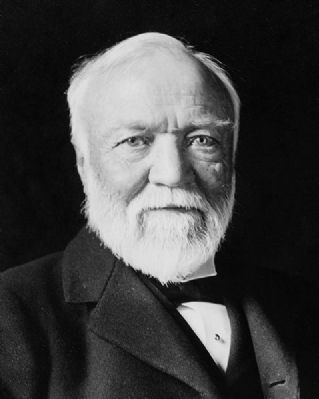Gaffney in Cherokee County, South Carolina — The American South (South Atlantic)
Carnegie Library
This Classical Revival building, built in 1913-14 and designed by Arthur W. Hamby, was one of 14 public libraries built in S.C. between 1903 and 1916 with funding from Andrew Carnegie and Carnegie Foundation. A 1938 addition compatible to the original design doubled its size. It served as the Cherokee County Public Library until 1972 and has housed county offices since that time. The building was listed in the National Register of Historic Places in 2000.
Erected 2001 by City of Gaffney and Cherokee County Council. (Marker Number 11-6.)
Topics and series. This historical marker is listed in these topic lists: Education • Notable Buildings. In addition, it is included in the Carnegie Libraries series list. A significant historical year for this entry is 1903.
Location. 35° 4.404′ N, 81° 38.916′ W. Marker is in Gaffney, South Carolina, in Cherokee County. Marker is on North Limestone Street (State Highway 150), on the right when traveling north. Touch for map. Marker is at or near this postal address: 210 North Limestone Street, Gaffney SC 29340, United States of America. Touch for directions.
Other nearby markers. At least 10 other markers are within walking distance of this marker. Cherokee County Veterans Monument (here, next to this marker); Cherokee County WW I Rememberence (here, next to this marker); Col. James Williams (a few steps from this marker); Michael Gaffney Home (within shouting distance of this marker); First Baptist Church (within shouting distance of this marker); 09.11.2001 (about 300 feet away, measured in a direct line); Capri Theater (about 400 feet away); Gaffney Cornerstone (about 500 feet away); Gaffney (about 600 feet away); Cherokee County Confederate Monument (about 600 feet away). Touch for a list and map of all markers in Gaffney.
Regarding Carnegie Library. National Register of Historic Places:
Carnegie Free Library (added 2000 - Building - #00000587)
♦ Also known as Cherokee County Administration Building
210 N. Limestone St., Gaffney
♦ Historic Significance: Architecture/Engineering
♦ Architect, builder, or engineer: Miller, S.A., Hamby, Arthur W.
♦ Architectural Style: Classical Revival
♦ Area of Significance: Architecture
♦ Period of Significance: 1900-1924, 1925-1949
♦ Owner: Local Gov't
♦ Historic Function: Education
♦ Historic Sub-function: Library
♦ Current Function: Government
♦ Current Sub-function: Government Office
Also see . . .
1. Carnegie Library Buildings in South Carolina. (Submitted on April 24, 2008, by Mike Stroud of Bluffton, South Carolina.)
2. Carnegie Foundation. Carnegie Foundation for the Advancement of Teaching, founded by Andrew Carnegie in 1905 and chartered in 1906 by an Act of Congress (Submitted on April 24, 2008, by Mike Stroud of Bluffton, South Carolina.)
3. Neoclassical Architecture. Neoclassical architecture was an architectural style produced by the neoclassical movement that began in the mid-18th century, manifested both in its details as a reaction against the Rococo style of naturalistic ornament, and in its architectural formulas as an outgrowth of some classicizing features of Late Baroque. (Submitted on December 18, 2011, by Brian Scott of Anderson, South Carolina.)
4. Carnegie Free Library. The Carnegie Free Library, built 1913-1914 as one of fourteen public libraries built in South Carolina between 1903 and 1916 with funding from Andrew Carnegie and the Carnegie Foundation, is significant both as an example of Classical Revival public architecture and for its role as Gaffney’s first public library. (Submitted on October 23, 2009, by Brian Scott of Anderson, South Carolina.)
5. Andrew Carnegie. Andrew Carnegie (25 November 1835 – 11 August 1919) was a Scottish industrialist, businessman, entrepreneur, and a major philanthropist. (Submitted on October 23, 2009, by Brian Scott of Anderson, South Carolina.)
Additional commentary.
1. Carnegie Free Library - National Register Nomination Form (2000)
The Carnegie Free Library is a one-story-over-raised-basement red brick Classical Revival building constructed in 1913-14, according to the designs of Arthur W. Hamby, of the well-known Columbia, South Carolina, architectural firm of Hamby & Rorke. Facing north, it is located at 210 Limestone Street, the main street in downtown Gaffney. It is situated across the street from the Gaffney municipal buildings and between the First Baptist Church and a Main Street parking lot. The gently pitched standing seam metal roof is hidden from view by a brick parapet which wraps around all four sides of the rectangularly-shaped building.
Set upon a brick basement, the two levels are delineated by a heavy limestone watertable. Granite steps flanked by stepped cast stone-capped pedestals lead to the centrally-located double-leaf wood and glass paneled doors at the entry to the main (second) floor of the building. CARNEGIE FREE LIBRARY is inscribed in limestone immediately above the entrance, however, is presently obscured by a wooden
sign which reads CHEROKEE COUNTY ADMINISTRATION BUILDING. The building's slightly projecting central pavilion or frontispiece is limestone and features six horizontal brick inset panels on either side of the entrance, as well as two decorative metal and milk glass globe light fixtures. The composition is completed with a box bracketed, projecting cornice. Flanking the main entrance are tripartite decoratively-traceried Neoclassical style windows [now painted White] with wooden slat awnings placed high along the front wall of the building. Beneath each set of windows is a large underpanel framed in brick with limestone corner blocks and featuring a field of brick laid in a basketweave pattern. A bronze memorial plaque to Cherokee County's World War I dead is centrally placed upon the underpanel at the left of the building's entrance. The building's two front corners are quirked, and a projecting classical cornice completely encircles the building.
The first floor is partially below grade and two triple, six-light panels of windows, corresponding to those on the upper level, flank a lower double-leaf wooden door entry reached by cast stone steps from either side. This lower entry is hidden from view by the main entrance steps.
The west and east [side] elevations each exhibit two sets of quadruple Neoclassical style windows on the upper level, as well as underpanels
identical to those on the front of the building. The rear set of windows on the west elevation has a wooden awning identical to those on the front. The lower level of the west elevation contains a paired six-light window on the front [original section], a set of four sixlight windows on the rear addition, and an intervening door to the basement level. The original section of the east elevation features a paired set of windows identical to those on the west elevation, Two glass and wood paneled doors, as well as a single six-light window are located on the historic addition of the east elevation.
The south [rear] elevation's upper level has symmetrically placed tripartite Neoclassical style windows, the one nearest the southwest corner of the building still with its wooden slat awning. Unlike the other elevations, these sets of windows have no decorative underpanels. The lower rear level has two triple six-pane windows corresponding to the central and left [westernmost] upper window sets, while two smaller windows are present beneath the easternmost upper window set. Most windows are presently painted white both inside and out.
In 1937, the original structure, as designed by architect Arthur W. Hamby, was doubled in size by a rear addition. In the western and eastern sides of the building, a subtle distinction can be detected among the red bricks separating the
original building from the 1937 addition. A matching standing seam metal pitched roof was added to the addition with the original rear wall being left to act in part as a firewall between the sections. S.A. Miller, a Gaffney contractor/builder, closely followed Hamby's original design for this addition. The exterior of the building retains its architectural and historical integrity.
The interior original pressed-metal ceiling, plaster walls and decorative crown molding are intact, but obscured by a dropped acoustical ceiling. In 1972, when a modern Cherokee County Library was built at another site, the county modified the Carnegie Free Library interior to serve as the Cherokee County Administration Building. The ceiling was lowered and modern composition wood paneled upper or main level. The lower level, used for offices and storage, retains more of its historic finishes.
A granite monument marking the grave of Colonel James Williams, erected by the Daniel Morgan Chapter of the Daughters of the American Revolution in 1917, is located on the western side of the front lawn; it includes two reproduction American Revolutionary War-era cannon and cannonballs. A granite war memorial obelisk in memory of Cherokee County soldiers killed in World Wars I and II, the Korean War, and the Vietnam War, erected by the Cherokee County Veterans' Council in 1982, is located on
the eastern side of the front lawn.
Significance
The Carnegie Free Library, built 1913-14 as one of fourteen public libraries built in South Carolina between 1903 and 1916 with funding from Andrew Carnegie and the Carnegie Foundation, is significant both as an excellent example of Classical Revival public architecture and for its role as Gaffney's first public library. It is representative of the trend toward the establishment of American public libraries in the late nineteenth and early twentieth centuries.
The library, funded by the Carnegie Foundation upon application by the Gaffney Women's Club, was built at a cost of $7,500 on a site donated by the city of Gaffney. The Women's Club also sponsored a campaign to approve an increase in local taxes in support of the library. The building, as designed by Columbia, South Carolina, architect Arthur W. Hamby in 1913-14, measured 28' x 30' and opened to the public in 1914. In 1936 Mayor R.C. Swofford and town librarian Mrs. Pratt Pierson formed a committee to plan an addition to the Carnegie Free Library intended to double the floor plan and establish a complete children's department. A one-half-mill tax levy raised $3,000, and the bricks for the addition were salvaged from the Irene Garage, which had been recently destroyed by a tornado. The addition was opened to the public in early 1938.
The
Carnegie Free Library building, since its dedication in 1914, has served the citizens of Cherokee County; it has been in continual use since that time. For its first fifty-eight years, as the county public library, it was a center for education and cultural enlightenment. It has functioned since essentially as an annex to the county courthouse.
— Submitted October 23, 2009, by Brian Scott of Anderson, South Carolina.
Credits. This page was last revised on June 16, 2016. It was originally submitted on April 24, 2008, by Mike Stroud of Bluffton, South Carolina. This page has been viewed 1,395 times since then and 30 times this year. Photos: 1. submitted on April 24, 2008, by Mike Stroud of Bluffton, South Carolina. 2. submitted on October 23, 2009, by Brian Scott of Anderson, South Carolina. 3, 4, 5. submitted on April 24, 2008, by Mike Stroud of Bluffton, South Carolina. 6, 7. submitted on October 23, 2009, by Brian Scott of Anderson, South Carolina. 8. submitted on December 18, 2011, by Brian Scott of Anderson, South Carolina. • Craig Swain was the editor who published this page.
